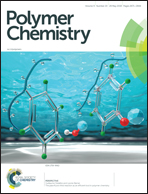Precise synthesis of poly(N-acryloyl amino acid) through photoinduced living polymerization†
Abstract
Amino acid-based polymers possess exceptional physical structures, chemical properties, and biocompatibility and have shown great potential in applications, including drug delivery, chiral recognition, and sensor materials, among others. The precise synthesis of amino acid-based polymers with defined chemical structure and functionality facilitates the exploration of prospective properties and therefore potential practical applications. Controlled/“living” radical polymerization techniques are powerful tools for the synthesis of amino acid-based polymers due to their tolerance toward functional groups and versatility of polymerisable monomer families. In this work, we used photoinduced electron/energy transfer-reversible addition–fragmentation chain transfer (PET-RAFT) polymerization to polymerize various N-acryloyl amino acid monomers with diverse chirality and functionality to prepare a library of amino acid-based polymers with controlled molecular weights and narrow molecular weight distributions (Mw/Mn < 1.20) under mild conditions. Different solvents, RAFT agents and photocatalysts have been investigated to show the robustness and versatility of this process. Amino acid monomers with unprotected di-carboxylic acid moieties were directly polymerized in methanol to provide a facile approach to prepare various well-defined homo- and di-block amino acid-based polymers.



 Please wait while we load your content...
Please wait while we load your content...